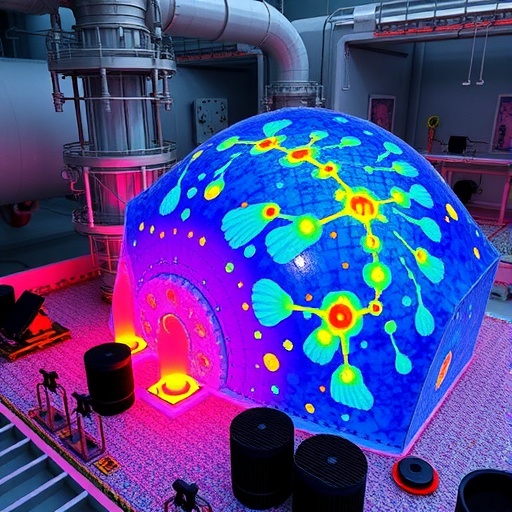In the rapidly evolving landscape of energy research, natural gas hydrates have emerged as a critical topic owing to their immense potential as an unconventional energy resource. Recently, a groundbreaking study by Lu, Shi, and Zhang has illuminated the intricate pressure dynamics within natural gas hydrate core samples, offering unprecedented insights into the behavior and stability of these enigmatic ice-like compounds. Published in Environmental Earth Sciences in 2025, this research not only advances fundamental understanding but also paves the way for safer and more efficient exploitation strategies.
At the heart of this study lies an innovative testing system meticulously designed to probe the pressure parameters of natural gas hydrate cores under realistic reservoir conditions. The design and calibration of this system represent a significant technical feat, enabling researchers to simulate the high-pressure and low-temperature environments characteristic of subsurface hydrate deposits. This is crucial because the stability and dissociation of gas hydrates are profoundly influenced by pressure variations, which directly affect energy recovery potential and environmental risks.
Natural gas hydrates are crystalline substances formed when methane molecules are trapped within water cages at high pressures and low temperatures, typically found in deep ocean sediments and permafrost regions. Their energy content surpasses all conventional fossil fuels combined, yet their extraction poses formidable challenges, primarily due to the risk of destabilization leading to uncontrolled methane release. Therefore, understanding the pressure-dependent behavior of hydrate cores is indispensable for advancing field-scale exploitation.
The experimental system developed by Lu and colleagues incorporates a pressure vessel capable of maintaining precise control over environmental variables while subjecting hydrate cores to dynamic stress regimes. This allows for the monitoring of phase transitions, volume changes, and mechanical responses during pressure fluctuations. Such granular data were previously unattainable, thereby marking a significant leap in hydrate research methodology.
Through a series of meticulously planned experiments, the team observed how hydrate cores respond to incremental pressure changes, simulating scenarios akin to drilling, production, and natural geological events. Notably, they documented threshold pressures beyond which hydrates begin to dissociate, releasing methane gas and altering core integrity. These thresholds are pivotal in designing safe extraction protocols to avoid sudden destabilizations.
Moreover, the authors quantified the influence of pressure on the porosity and permeability of hydrate-bearing sediments. These parameters critically dictate gas flow and storage capacity within the reservoir and have direct implications on the efficiency of methane recovery. The pressure-dependent permeability data acquired challenge previously held assumptions that sediments remain largely static during depressurization processes.
The study also delved into the hysteresis effects observed during pressure cycling, revealing that hydrate cores do not simply revert to initial states when original pressures are restored. This irreversible behavior highlights the complex physicochemical interactions within hydrate-bearing sediments, likely influenced by microstructural alterations and gas-water redistribution at pore scales.
In addition to experimental results, Lu et al. employed advanced modeling techniques to correlate observed pressure behaviors with thermodynamic and mechanical theories. Their comprehensive approach bridges empirical findings with predictive frameworks, facilitating more reliable estimations of hydrate stability zones across various geological settings. This fusion of experiment and simulation enhances the robustness of their conclusions.
One of the most impactful implications of this research resides in environmental risk assessment. Methane, a potent greenhouse gas, poses significant climate threats if released abruptly from destabilized hydrates. By identifying pressure boundaries and dissociation kinetics, the findings provide critical data enabling energy developers and policymakers to better predict and mitigate methane leakage during resource exploitation or natural disturbances like earthquakes and submarine landslides.
The research also carries substantial importance for drilling operations in hydrate-rich sediments. Pressure management strategies informed by this study could prevent wellbore collapse and blowouts, thereby enhancing operational safety. The subtle interplay between pressure, hydrate dissociation, and sediment mechanics uncovered brings new perspectives to drilling engineering in challenging environments.
Importantly, the study emphasizes that pressure is not a monolithic factor but instead interacts with temperature, gas composition, and sediment characteristics to define hydrate system behavior. Future studies will need to incorporate these multidimensional variables, but the present work provides an indispensable foundation by isolating and characterizing pressure’s dominant role.
The timing of this research addresses urgent global calls for cleaner energy transitions by unlocking natural gas hydrate potential, which could supply vast amounts of low-carbon methane. However, the delicate balance between resource utilization and environmental protection hinges on deep scientific understanding—precisely what Lu, Shi, and Zhang’s experimental system begins to furnish.
Looking forward, the research community anticipates that this testing apparatus will become a standardized tool for laboratories worldwide, enabling systematic comparison of hydrate properties and facilitating accelerated innovation. Its modular design and adaptability to various sediment types promise widespread applicability.
In summary, this study exemplifies the convergence of engineering ingenuity, geoscientific inquiry, and environmental stewardship. By decoding the pressure-dependent intricacies of natural gas hydrate cores, Lu and colleagues have charted a path toward safer, more efficient, and environmentally conscious exploitation of one of Earth’s most enigmatic energy reservoirs.
Ultimately, their work stands as a testament to the critical role that controlled, precise experimentation plays in bridging theoretical understanding with practical applications in energy and environmental sciences. As the global energy landscape undergoes radical transformation, studies like this will be foundational in ensuring a sustainable energy future.
Subject of Research: Pressure behavior and stability analysis of natural gas hydrate core samples using a novel testing system.
Article Title: Testing system and experimental study of pressure parameters of natural gas hydrate core samples.
Article References:
Lu, C., Shi, J. & Zhang, T. Testing system and experimental study of pressure parameters of natural gas hydrate core samples. Environ Earth Sci 84, 314 (2025). https://doi.org/10.1007/s12665-025-12331-z
Image Credits: AI Generated




